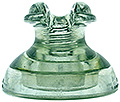
- Home
- Hemingray 101
Hemingray Company History

First of all, I will preface this by saying that this is only a brief history on one of the most influential and long-lived insulator companies in history. This is by no means a complete or comprehensive guide (there's an entire book for that!), but my intent is to give you a jumping-off point should you be interested in learning more about the many facets of the Hemingray Glass Company! While the focus of this overview is specific to insulators, Hemingray also produced a wide range of glassware over its long history as well (largely outside the scope of this web site).
The Hemingray Glass Company as we know it actually began in 1848 under a different name, Gray & Hemingray, when Robert Hemingray and Ralph Gray formed a partnership and established a glass works in Cincinnati, Ohio. They wouldn't start producing insulators until the 1850s with the production of lightning rod insulators and "telegraph glasses". While a plethora of lightning rod insulators exist in the hobby, at this time we do not know exactly which ones were produced by Hemingray.

In 1852, they began moving their operations to Covington, Kentucky. In the 1850s and 1860s, the company went through several name changes, and in 1870 the Hemingray Glass Company was incorporated. The first big break for Hemingray came on December 19, 1871, when Robert Hemingray received a patent for an improved technique for molding insulators. Many of Hemingray's early insulators bear this patent date. If you ever wondered why later, H.G.CO. and Hemingray-embossed insulator style numbers start at №7, there were actually style numbers 1 through 5 as well — they can all be found embossed with the December patent date!

In 1888, after two consecutive years of flooding at its Cincinnati location, Hemingray opened their second factory in Muncie, Indiana where insulator production continued. Their second big patent break was on May 2, 1893, where Ralph G. Hemingray and James C. Gill received their patent for drip points, a feature that was designed to draw condensation off of the insulator and prevent the water from causing a short from the insulator to the wooden pin. Many of Hemingray's insulators bore this patent date for decades, with specimens dating well into the 1920s. The Covington location closed around 1919.

The 1930s was a big change for Hemingray, when the company was purchased by Owens-Illinois, and they began producing clear insulators as the "Hemingray Division." They also phased out any usage of sharp drip points, and replacing them with round drip points. In 1937, Hemingray manufactured its one billionth insulator, quite a feat for any glass company! And quite possibly the only glass company to do so (I have not heard of another!)

Around 1935, Hemingray began manufacturing some insulator designs with brass bushings embedded in the threads (to protect against pin expansion). In 1939, the LOWEX line of power insulators was introduced, which stood for "Low Expansion, Low Expense." It used borosilicate rather than soda-lime glass, but ironically was more expensive to produce, so it was discontinued by 1941.

In 1951, Owens-Illinois changed the Hemingray branded line of insulators designed for primary power distribution to the Kimble trademark, and a handful of styles can be found with this embossing (in many cases engraved over "Hemingray".) However, insulator production also continued under the Hemingray trademark as well. The corrugated base was also introduced as an alternative to drip points, which resembled a roughed, cross-hatch style base intended to disrupt moisture from creeping up the inside of the skirt.
In 1967, the last Hemingray insulator was produced. The Muncie, Indiana factory continued to manufacture glass TV face panels, but closed permanently in 1972. Thus ended the long history of America's largest glass insulator manufacturer.